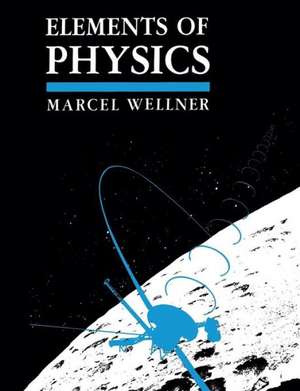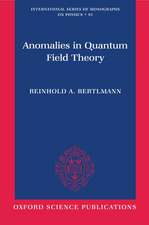Elements of Physics
Autor M. Wellneren Limba Engleză Paperback – 14 noi 2013
Preț: 423.73 lei
Nou
Puncte Express: 636
Preț estimativ în valută:
81.08€ • 84.87$ • 67.48£
81.08€ • 84.87$ • 67.48£
Carte tipărită la comandă
Livrare economică 01-15 aprilie
Preluare comenzi: 021 569.72.76
Specificații
ISBN-13: 9781461367239
ISBN-10: 1461367239
Pagini: 716
Ilustrații: XIII, 696 p.
Dimensiuni: 189 x 246 x 38 mm
Greutate: 1.26 kg
Ediția:Softcover reprint of the original 1st ed. 1991
Editura: Springer Us
Colecția Springer
Locul publicării:New York, NY, United States
ISBN-10: 1461367239
Pagini: 716
Ilustrații: XIII, 696 p.
Dimensiuni: 189 x 246 x 38 mm
Greutate: 1.26 kg
Ediția:Softcover reprint of the original 1st ed. 1991
Editura: Springer Us
Colecția Springer
Locul publicării:New York, NY, United States
Public țintă
ResearchCuprins
1. Measurement.- A. Theories versus Data.- B. Precision in Numbers.- C. Distance.- D. Time.- Condensed Checklist.- True or False.- Problems.- 2. Motion.- A. Uniform Motion.- B. Accelerated Motion (One-Dimensional).- C. Vertical Free Fall.- D. Vectors.- E. Motion in a Plane.- F. Projectiles.- Condensed Checklist.- True or False.- Problems.- 3. Force.- A. The Law of Inertia (Newton’s First Law).- B. Force and Acceleration (Newton’s Second Law).- C. Combining Forces.- D. Action and Reaction (Newton’s Third Law).- E. Pulleys and Surfaces.- F. Effective Gravity.- Note.- Condensed Checklist.- True or False.- Problems.- 4. Energy.- A. Conservation of Energy in Free Fall.- B. Work.- C. Work and the Energy of a Particle.- D. Work and the Energy of a System.- E. Conservation of Total Energy.- Note.- Condensed Checklist.- True or False.- Problems.- 5. Momentum.- A. Conservation of Momentum.- B. Two-Body Collisions.- C. Force from a Jet.- D. The Center of Mass.- Note.- Condensed Checklist.- True or False.- Problems.- 6. Circular Motion.- A. Angular Variables.- B. Uniform Circular Motion.- C. Nonuniform Circular Motion.- Notes.- Condensed Checklist.- True or False.- Problems.- 7. Rotation and Torque.- A. Rotation About a Fixed Axis.- B. Torques in Terms of Forces.- C. Rotational Equilibrium.- D. Rotation and the Center of Mass.- E. Angular Momentum.- Notes.- Condensed Checklist.- True or False.- Problems.- 8. Gravity.- A. Astronomical Comments.- B. Universal Gravitation.- C. Orbits.- D. Gravitational Potential Energy.- Notes.- Condensed Checklist.- True or False.- Problems.- 9. Fluids.- A. Pressure and Density.- B. Archimedes’ and Pascal’s Principles.- Note.- Condensed Checklist.- True or False.- Problems.- 10. Heat.- A. Temperature.- B. Heat as Transferred Energy.- C.Specific Heat.- D. Phase Transitions.- Notes.- Condensed Checklist.- True or False.- Problems.- 11. Molecules and Gases.- A. The Existence of Molecules.- B. Atomic Masses and the Kilomole.- C. The Ideal-Gas Law.- D. Kinetic Theory.- E. Internal Energy and Heat Capacity.- Notes.- Condensed Checklist.- True or False.- Problems.- 12. Work from Heat.- A. Heat and the Conservation of Energy (First Law of Thermodynamics).- B. Heat Engines and the Second Law of Thermodynamics.- C. Entropy and the Waste of Energy.- D. The Logic of this Chapter.- Condensed Checklist.- True or False.- Problems.- 13. Vibrations.- A. Hooke’s Law and the Ideal Spring.- B. Harmonic Motion.- C. Superposition and Sound.- D. Resonance.- Condensed Checklist.- True or False.- Problems.- 14. Waves.- A. Traveling Waves in Strings.- B. Classifying Waves.- C. Sound in Gases.- D. Standing Waves.- Notes.- Condensed Checklist.- True or False.- Problems.- 15. Electric Charge and Itsfield.- A. The Electric Force.- B. The Electric Field.- C. The Electric Flux and Gauss’ Law.- Note.- Condensed Checklist.- True or False.- Problems.- 16. The Electric Potential.- A. Introducing the Potential.- B. Single Conductors in Equilibrium.- C. Capacitors.- D. Energy of the Electric Field.- E. Particles Controlled by Electric Fields.- Note.- Condensed Checklist.- True or False.- Problems.- 17. Direct Currents.- A. Ohm’s Law.- B. Electric Power.- C. Circuits.- D. Conduction.- Notes.- Condensed Checklist.- True or False.- Problems.- 18. Magnetic Forces.- A. Magnetic Poles and Fields.- B. Magnetic Force on a Moving Charge.- C. Magnetic Force on a Current.- Notes.- Condensed Checklist.- True or False.- Problems.- 19. Magnetic Fields from Currents.- A. The Law of Biot and Savart.- B. Proof by Action and Reaction.- C.Ampère’s Law.- D. Magnetic Poles: An Illusion.- Notes.- Condensed Checklist.- True or False.- Problems.- 20. Magnetic Induction.- A. Electric Field Seen by a Moving Object.- B. Moving Circuits.- C. Faraday’s Law of Induction.- D. Application to Coils.- E. The Induced Electric Field.- Note.- Condensed Checklist.- True or False.- Problems.- 21. Inductance and Alternating Currents.- A. Self-induction.- B. Natural Oscillations in a Circuit.- C. Alternating Currents.- Notes.- Condensed Checklist.- True or False.- Problems.- 22. Electromagnetic Waves.- A. Theory of Electromagnetic Waves.- B. Energy and Momentum in a Wave.- C. The Electromagnetic Spectrum.- Note.- Condensed Checklist.- True or False.- Problems.- 23. Geometrical Optics.- A. Wave Fronts and Rays.- B. Refraction of a Plane Wave.- C. Reflection of a Plane Wave.- D. Image Formation by Lenses.- E. Image Formation by Mirrors.- Notes.- Condensed Checklist.- True or False.- Problems.- 24. Waveoptics.- A. Interference by Reflection.- B. Diffraction from Slits.- C. Noncoherent Light.- D. Limits of Resolution.- E. Polarization.- Notes.- Condensed Checklist.- True or False.- Problems.- 25. Relativity.- A. The Michelson-Morley Experiment.- B. The Postulates of Relativity.- C. The Equivalence of Mass and Energy.- D. Time Dilation.- E. The Logic of this Chapter.- Notes.- Condensed Checklist.- True or False.- Problems.- 26. Waves Versus Particles.- A. Photoemission.- B. X Rays.- C. The Compton Effect.- D. Electron Waves.- E. The Role of Probability.- Note.- Condensed Checklist.- True or False.- Problems.- 27. Atomic Structure.- A. Energy Levels.- B. Bohr’s Model of the Hydrogen Atom.- C. Electron States and Their Four Quantum Numbers.- D. The Exclusion Principle and the Periodic Table.- Notes.- Condensed Checklist.-True or False.- Problems.- 28. The Nucleus.- A. The Stable Nuclei.- B. Radioactivity.- C. Nuclear Reactions.- Notes.- Condensed Checklist.- True or False.- Problems.- Appendices.












